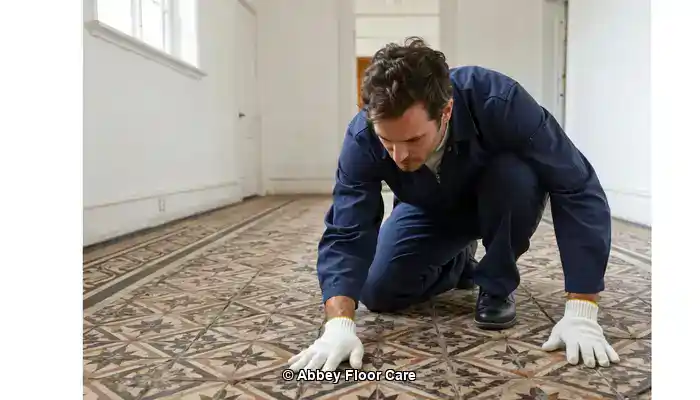
Restoring Colour and Pigment to Faded Victorian Mosaic Tiles
Last Updated on October 30, 2025 by David
Key Takeaways from this article, “Restoring Colour and Pigment to Faded Victorian Mosaic Tiles”:
- Victorian mosaic tiles often lose their colour due to ingrained dirt, old coatings, and surface wear, not just age.
- Harsh chemicals and aggressive scrubbing can strip original pigments, especially on encaustic and geometric tiles.
- Safe restoration starts with deep cleaning using pH-neutral solutions and low-speed rotary machines with soft brushes.
- Old sealers and waxes must be carefully removed to reveal the true condition of the tile surface.
- Colour enhancement is possible using breathable, stone-safe sealers that deepen tone without creating a glossy film.
- Professional restoration can revive original pigments without repainting or artificial colouring, preserving authenticity.
- Maintaining restored tiles requires gentle cleaning routines and avoiding acidic or bleach-based products.
- Heritage-sensitive methods protect both the aesthetic and historical value
Introduction to Victorian Tile Restoration
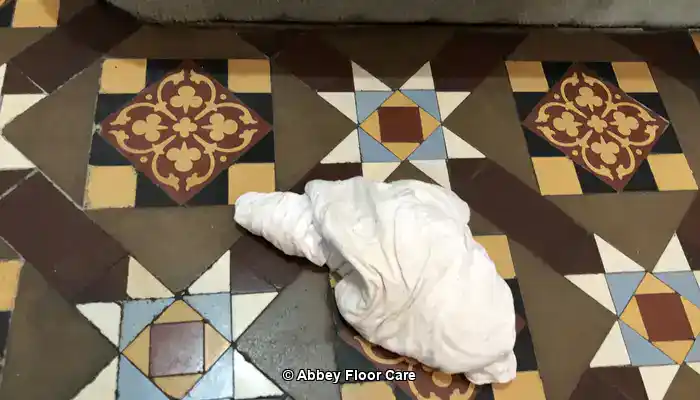
Abbey floor Care restoring the colour to a Victorian clay tile floor using a colour-enhancing impregnating sealer.
Victorian encaustic and mosaic tiles represent a significant part of British architectural heritage, admired for their detailed craftsmanship and distinctive colour palettes made from mineral pigments fused directly into the clay tile bodies.
Pro Tip: We recommend these products for daily Victorian maintenance cleaning.

Fila Pro Floor Cleaner
|

LTP Colour Intensifier & Stainblock H20
|

Vileda H2PrO Spin Mop System
|
Over time, however, these tiles often lose their visual impact due to surface wear, chemical effects, and environmental influences. Restoring their original vibrancy is a specialist task requiring an in-depth understanding of the materials, historically accurate techniques, and premium products.
Why Victorian Mosaic Tiles Fade and What Causes Surface Dulling
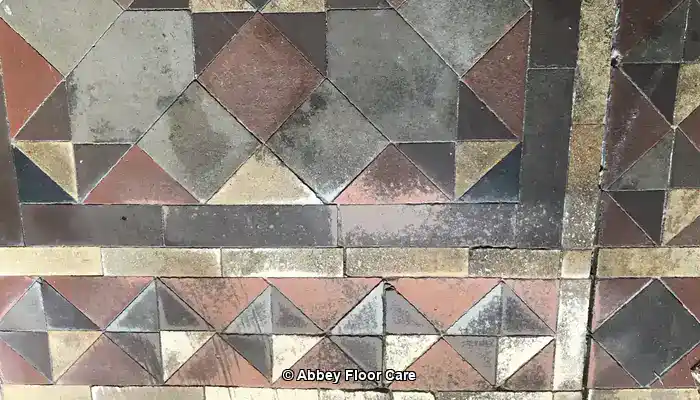
Example of Victorian Clay Tile Floor dulled through surface wear and damage.
Despite the pigments being integral to the tile, multiple factors lead to fading and dulling:
- Accumulated dirt and grime: Sequential foot traffic deposits fine particles and oils that absorb into porous surfaces, scattering light and muting colours.
- Wax and polish buildup: Layers of wax or sealants that lack breathability trap moisture, leading to a cloudy or yellowed appearance.
- Moisture-driven issues: Many Victorian tiles were laid over subfloors without damp-proof membranes, resulting in rising damp that transports soluble salts, which crystallise on the tile surface as efflorescence, further masking the original tones.
- Physical abrasion: Small surface scratches from years of wear disrupt smooth light reflection, diminishing visual richness.
Effective restoration carefully addresses each of these contributors without compromising the tile’s historic makeup.
The Crucial Role of Breathability When No Damp-Proof Membrane is Present
Because many Victorian tiled floors rest on older subfloors lacking a damp-proof membrane (DPM), their natural clay structure must remain permeable to allow subfloor moisture to evaporate. Non-breathable wax coatings or film-forming sealers block this evaporation pathway, leading to moisture buildup beneath the surface. This traps salts and humidity, which causes efflorescence, surface mineral degradation, and the undesirable phenomenon known as wax blooming—a whitish film or haze on the tile. Restoration plans must prioritise ethable impregnating sealers that protect tiles yet allow moisture vapour to move freely, preventing long-term damage.
Understanding Pigments and Tile Composition
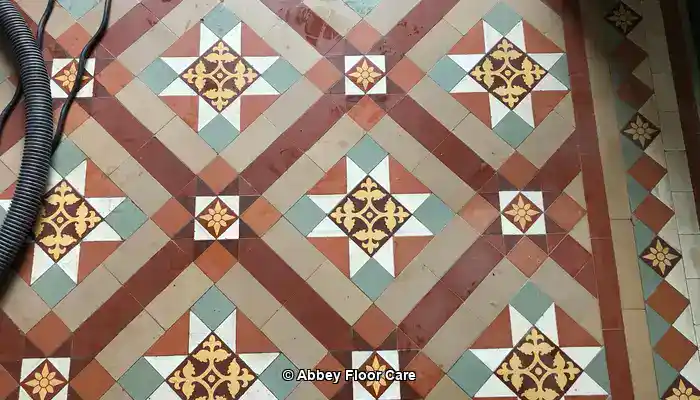
An example of different pigments in a Victorian Clay tile floor during restoration by Abbey Floor Care
Mineral Oxide Pigments in Victorian Tiles
Victorian mosaic and encaustic tiles gain their characteristic earthy colours from mineral oxide pigments embedded directly into the clay. These pigments provide durability and colour depth. The primary pigments include:
- Iron oxide: generates terracotta reds, rust browns, and soft ochres.
- Manganese: yields deep browns and rich blacks.
- Cobalt: imparts varying blue hues.
- Chromium: creates natural green shades.
Firing and Fusion Process
During manufacture, the tiles are fired at temperatures around 1100°C, vitrifying the clay and fusing the pigments deep into the tile body. This ensures the colour runs throughout the tile rather than sitting on the surface, offering long-lasting vibrancy.
Porous Unglazed Finish
Victorian tiles typically feature a porous, unglazed matte finish, producing a natural appearance. However, this porosity makes the tiles absorbent and sensitive to surface contamination and moisture, necessitating careful cleaning and maintenance.
Variability in Colour Durability
Natural earth pigments, especially in red and yellow tiles, contain fewer mineral additives than darker colours like black, which are formulated with manganese. This difference means red and yellow tiles are less hard-wearing and prone to surface dishing under heavy traffic. This wear manifests as shallow depressions where footfall is concentrated, resulting in uneven colour intensity and a loss of surface flatness.
Restoration Considerations
Understanding pigment composition and tile wear patterns is critical in restoration planning. Softer-toned tiles require gentler cleaning and tailored impregnating sealers that respect their physical properties while enhancing colour. Darker, harder tiles tolerate more intensive cleaning but still need breathable, colour-enhancing protection to maintain vibrancy over time.
Restorative Cleaning Techniques for Victorian Mosaic Tiles
Effective cleaning is essential to restore Victorian encaustic and mosaic tiles to their original vibrancy. However, cleaning these tiles requires a specialised approach that goes beyond using simple pH-neutral detergents commonly recommended. Professional restorers employ carefully formulated alkaline cleaners and mechanical techniques to break down heavy soiling and old residues without compromising the historic tile fabric.
Debris Removal
The cleaning process begins with removing all loose dirt and grit using soft brushes or vacuuming with brush attachments. This step is critical to prevent scratching the delicate tile surfaces during subsequent cleaning phases.
Alkaline Cleaners for Intensive Soil Removal
Unlike pH-neutral cleaners, which lack the chemical strength to tackle ingrained fatty acids and organic soils, alkaline cleaners are indispensable for thoroughly breaking down household oils, grease, and sticky residues often found on tile surfaces and in grout lines. These alkaline formulations dissolve the binding agents of dirt, sugars, and fats, allowing for their effective removal while maintaining compatibility with the mineral composition of Victorian tiles.
Professional-use alkaline products, such as PS87 PRO or custom formulations from heritage cleaning specialists, are typically used diluted. This ensures deep cleaning without over-aggression to the clay body. It is important to remember that, even with alkaline cleaners, caution is necessary and spot testing is recommended.
Mechanical Agitation with Appropriate Pads
Mechanical action enhances cleaning effectiveness. Low-speed rotary scrubbers fitted with red or, sometimes, green non-abrasive pads are commonly used to agitate soils out of small pits, tile surfaces, and grout lines. These pads clean thoroughly while safeguarding the integrity of tile edges and delicate surface details.
Removal of Waxes and Exotic Sealants
Years of use often lead to the accumulation of old waxes and sealants, especially from DIY attempts using inappropriate products. Water-based cleaners—either alkaline or mildly acidic—are preferred for removing these residues without damaging the tile’s mineral structure. However, stubborn ‘exotic’ or solvent-resistant coatings require targeted solvent-based removers such as Lithofin Wax-Off or LTP Solvex. These solvents effectively soften and emulsify waxes and old sealants, but must be handled carefully by professionals trained in their safe application and disposal.
Rinsing and Drying
After chemical cleaning, thorough rinsing is critical to remove all cleaning residues. Multiple rinses with clean water, combined with wet vacuum extraction, ensure that no detergent or solvent traces remain to interfere with subsequent restoration coatings.
Drying time varies depending on environmental conditions, such as humidity, surface type, and moisture. Restoration experts always use moisture meters to confirm that the tiles are fully dry before applying any impregnating sealers or protective treatments. This approach prevents moisture entrapment, which could otherwise lead to efflorescence, staining, or damage beneath sealed layers.
Benefits of Thorough Cleaning
Comprehensive cleaning reveals the actual condition of the tiles by removing visual obstructions. It exposes areas that may require repair and provides a clean, receptive surface for colour-enhancing impregnators or other restorative products. This careful preparation is fundamental to the success and longevity of Victorian mosaic tile restoration.
Colour Enhancement with Premium Impregnating Sealers
Restorers use impregnating colour-enhancing sealers manufactured by LTP, and Lithofin, brands recognised for their advanced, heritage-approved formulations. Unlike superficial coatings, these sealers:
- Penetrate deeply into tile pores to physically enrich colour by altering light refraction.
- Maintain vapour permeability, which is essential for moisture escape and is especially critical in older floors without DPM layers.
- Provide durable protection against stains and foot traffic without altering natural texture or gloss.
- They are applied in multiple light coats, each allowed to penetrate before the next is used to ensure complete uniformity.
These sealers directly address fading by restoring vibrancy while preserving the historic floor’s breathable nature.
Physical Repair of Damaged Tiles and Colour Tinting
Tiles with chips, cracks, or missing pieces require careful repair using tinted epoxy or lime-based mortars, colour-matched with natural mineral oxides. Restoration experts source matching replacement tiles from salvage archives to preserve pattern continuity. Colour tinting involves selectively applying earth-pigment-infused wax or resin mixtures to blend worn or missing pattern areas sensitively, while respecting tile breathability and reversibility.
Best Practices in Tinting
- Use small, controlled applications to avoid overt colouring.
- Conduct patch testing on inconspicuous areas before complete application.
- Ensure compatibility with the impregnating sealers applied to the entire surface.
Maintenance of Restored Victorian Mosaic Floors
Preserving restored colour and condition requires ongoing care:
- Routine cleaning with pH-neutral, non-abrasive detergents designed for historic tiles.
- Preventive measures, such as placing entrance mats to minimise dirt ingress.
- Promptly remove liquid spills, especially acidic substances like vinegar or wine, to prevent surface etching.
- Regularly reapply breathable impregnating sealers every 3–5 years or as wear dictates.
- Monitoring floors for signs of efflorescence or moisture ingress indicative of underlying damp issues.
Common Restoration Pitfalls
- Avoid wax treatments that can block breathability, cause efflorescence, or lead to wax blooming.
- Do not use acrylic or polyurethane sealants that trap moisture and cause degradation.
- Limit the use of harsh chemical cleaners, as they can erode clay and pigments.
- Never repaint tiles; paint films alter their visual and physical properties and are not reversible.
- Recognise and address the issues in older subfloors before sealing.
Real-World Restoration Projects
Examples highlight the successful application of these principles:
A Victorian hallway restoration in Sheffield.
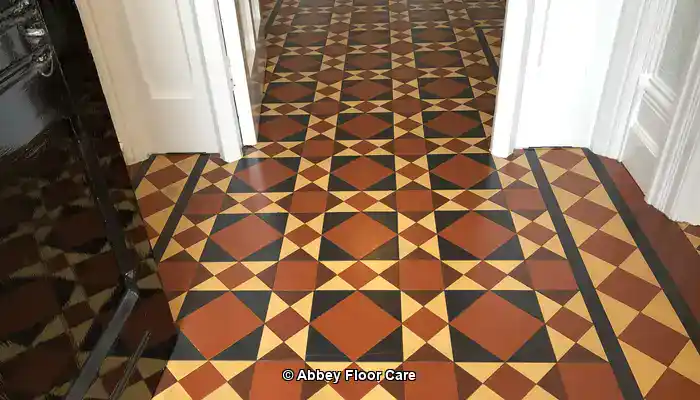
Our cleaning removed years of wax and grime, followed by a Lantania Avo colour-enhancing impregnating sealer, which visibly deepened tile colours. This was followed by applying an acrylic topical sealer to provide surface protection on floors installed over a damp-proof membrane.
A restored civic mosaic floor in Chesterfield.
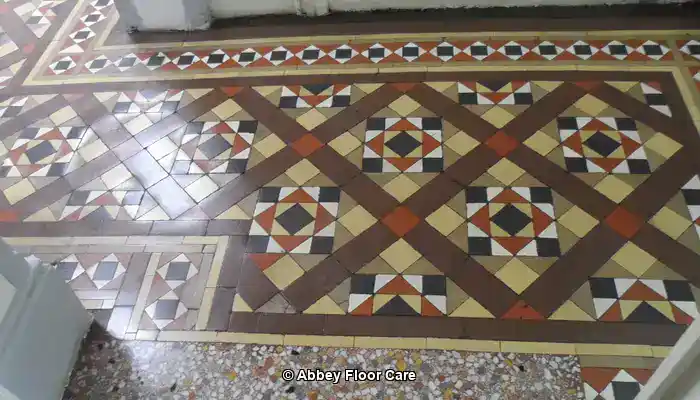
After cleaning and removing old topical sealers, the floor was sealed with an LTP Colour Enhancing Impregnating sealer. The surface was further protected with a wax, carefully applied to seamlessly integrate the clay tiles into the historic fabric of the building.
Conclusion: Preserving Heritage Through Expert Restoration
Restoring the colour and pigment of Victorian mosaic tiles is a complex task that balances material science, craftsmanship, and sensitivity to heritage values. Using premium impregnating colour-enhancing sealers from industry leaders like Dry Treat, Lantania, and Lithofin ensures long-term breathability, protection, and colour vibrancy. Skilled cleaning, careful repair, and dedicated maintenance maintain authenticity while rejuvenating these historic floors for generations to enjoy.
FAQs
What are Victorian mosaic tiles?
Victorian mosaic tiles are decorative tiles popular in the 19th century, known for their vibrant colours and intricate patterns. They were often used in public buildings and homes.
How can I restore faded Victorian mosaic tiles?
Restoring faded Victorian mosaic tiles involves cleaning, repairing damages, applying new pigments to match the original colours, and then sealing the tiles to protect them.
What materials are needed for tile restoration?
Essential materials for tile restoration include specialised cleaning solutions, pigments, adhesives, grout, and protective sealants, all chosen for compatibility with the original tiles.
How long does tile restoration take?
The duration of tile restoration varies depending on the size and condition of the area being restored, typically ranging from a few days for small projects to several weeks for larger restorations.
Can I do the restoration myself?
Yes, smaller restoration projects can be DIY if you have the necessary skills and tools, but more complex repairs require expertise to ensure quality results.
What is the cost of restoring Victorian mosaic tiles?
Costs can vary significantly based on project size and condition, ranging from a few hundred to thousands of pounds for comprehensive restorations.
How do I choose the right restoration expert?
Look for restoration professionals with experience in historical projects, good reviews, and a commitment to using authentic materials and techniques.
What challenges do restorers face?
Restorers often face challenges such as matching original colours, repairing damaged tiles, and ensuring the longevity of the restoration work.
How can I maintain restored tiles?
Regular cleaning with pH-neutral products, avoiding harsh chemicals, resealing periodically, and promptly addressing any damage are key to maintaining restored tiles.
What innovations are present in tile restoration today?
Recent innovations include advanced cleaning solutions, new types of sealants, and digital technology for precise colour matching and pattern replication in restoration projects.
Recent Posts:
We work throughout the country, just some of our work counties:
Copyright © Fabritec - Abbey Floor Care. Natural Stone Floor Restoration in Surrey and South West London FAQ - Privacy Policy - Terms And Conditions